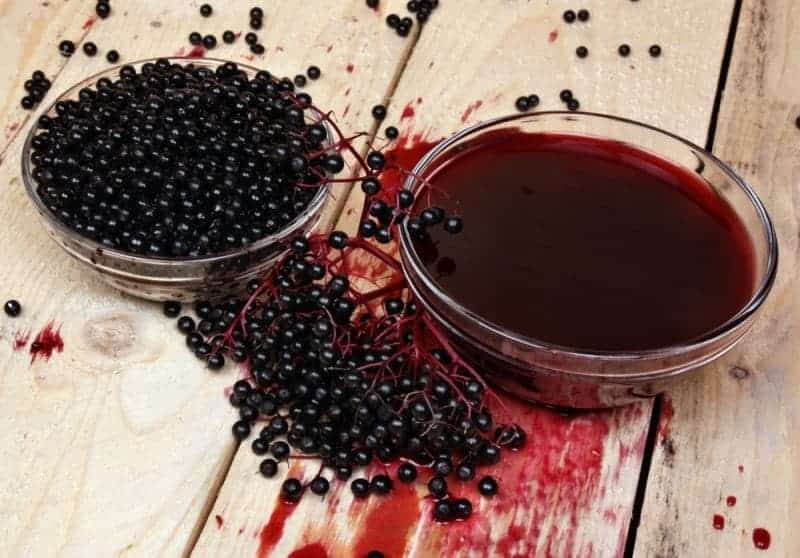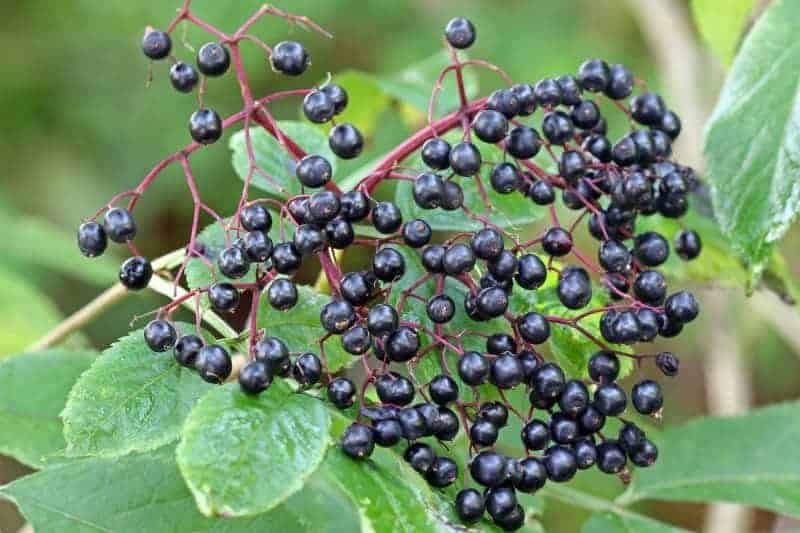This post was most recently updated on September 15th, 2020
Dried elderberries are used to make both elderberry syrup and added to teas. It is easy to dry elderberries at home even if you don’t have a dehydrator. If you have access to elderberry trees, you will find that the berries all ripen at about the same time. Dehydrating elderberries yourself means that you can store them safely to use later without taking up your freezer space. Drying elderberries preserves their medicinal qualities and allows you to make effective elderberry syrup when you need to.
Please read: This information is provided for educational purposes only and is not intended to treat, diagnose or prevent any disease. We encourage you to make your own health care decisions in partnership with a qualified health care professional.
This post contains affiliate links, this means at no extra cost to you, we make a commission from sales. Please read our Disclosure Statement
How do you dry elderberries?
There are 3 easy ways to dry elderberries – air dry, oven dry and in a dehydrator. Berries dried in a dehydrator give you a superior end product, but drying berries the other two ways also work if you don’t have a dehydrator at home.
How do I dry elderberries without a dehydrator?
How long can you keep dried elderberries?
If cared for properly, dehydrated elderberries have a shelf life of up to one year. To preserve the freshness of your dried elderberries you should:
- Avoid exposure to direct sunlight
- Keep in a sealed jar
- Store at room temperature or below
RELATED POST: How to make elderberry syrup
Can you eat dried elderberry?
Elderberries can be used in baking, making teas or making syrup. Elderberries contain a cyanogenic glycoside sambunigrin (1) which must be deactivated by heating before you eat or drink elderberry. Thankfully this evaporates at 26C which is lower than blood temperature, so just be sure to cook your berries and you will be fine.
The seeds, stems, leaves and roots of the elderberry tree are all poisonous to humans. They contain a cyanide-inducing glycoside. Eating a sufficient quantity of these cyanide-inducing glycosides can cause a toxic buildup of cyanide in the body and make you quite ill.
RELATED POST: How to dehydrate vegetables
Preparing elderberries for drying
When you are picking your elderberries, be sure to pick the ripe ones because the unripe ones could make you sick. Pick out any green ones that you find.
The berry bunches come off the tree easily, a pair of scissors can help immensely as well.
When you bring your berries home, if you cannot process them immediately, then pop them in the fridge.
To get the berries off the stem you can comb them with a fork, or pop them in the freezer until the berries are just frozen and then put them in a bag and give them a few whacks on the counter, the berries will come right off the stems.
Remember to remove all the leaves and flowers.
Wash the berries with clean water in a colander or sieve. Then, leave them on paper towels or use a strainer to remove excess water.
RELATED POST: How to can plums
Drying Elderberries at Home
There are various ways to dry elderberries. You can do it under the sun, with a dehydrator, or with an oven. All three methods are effective but vary in terms of drying time.
Sun-drying elderberries
This method is pretty easy and straightforward to do, try and pick a time when you are expected to have a few days of nice weather.
Lay your berries out in a single layer on trays and sit them on a sunny windowsill.
Make sure that the drying area is far away from dust and dirt but is in a position to receive direct sunlight.
Leave the elderberries to dry. It usually takes three days, but drying time can be longer or shorter depending on the weather.
Stir the berries twice a day and then flatten them out in a single layer again. They will look like raisins when they are successfully dried, if they are still soft and squishy then leave them longer, the drier they are the longer they will keep.
RELATED: How to propagate your own elderberry bushes
Drying elderberries in a food dehydrator
This method usually takes 10-12 hours depending on the temperature that you set and how good your dehydrator is.
Place the elderberries in a single layer on top of some baking paper on top of your dehydrators trays.
Set the dehydrator to 140 degrees Fahrenheit (60 degrees Celsius) for 10 hours. After this time double-check if the elderberries are dry enough by pinching them. If they are still soft, return them to the dehydrator until they are dry.
This is my favourite method as I set up my dehydrator and go to bed, I wake up in the morning to nice dried berries, no stirring or watching required!
RELATED: Which Food Dehydrator is Right for You

Drying elderberries in the oven
Set your oven to 140 degrees Fahrenheit (60 degrees Celsius), if you have a fan option then turn this on also.
Make sure to set the right temperature — elderberries are quite delicate and you would not want to burn them!
Place the elderberries on a baking tray/cookie sheet lined with baking paper making sure the berries are only one berry thick, if they bunch up they take way longer to dry.
From time to time, check if they are being dried properly to prevent overcooking. You will want to stir them every hour or so. This process could take all day, so be prepared to wait. Raising the temperature will only burn your berries which is not a great plan.
Once dry, take out the berries and leave to cool.
How to store dried elderberries
Storing dried elderberries is pretty easy, and they will last up to a year if you keep them out of the sunlight and away from direct heat.
After drying, collect the elderberries, leave them to cool thoroughly, and keep them in a glass container or jar with a lid that seals.
Make sure you label them with what they are and what date you packed them – they look surprisingly a lot like peppercorns!
If your berries start to grow mould, then they were not properly dehydrated.
Having your own supply of dried elderberries in your pantry means that you can make your family elderberry syrup before winter to help stave off colds and the flu.


